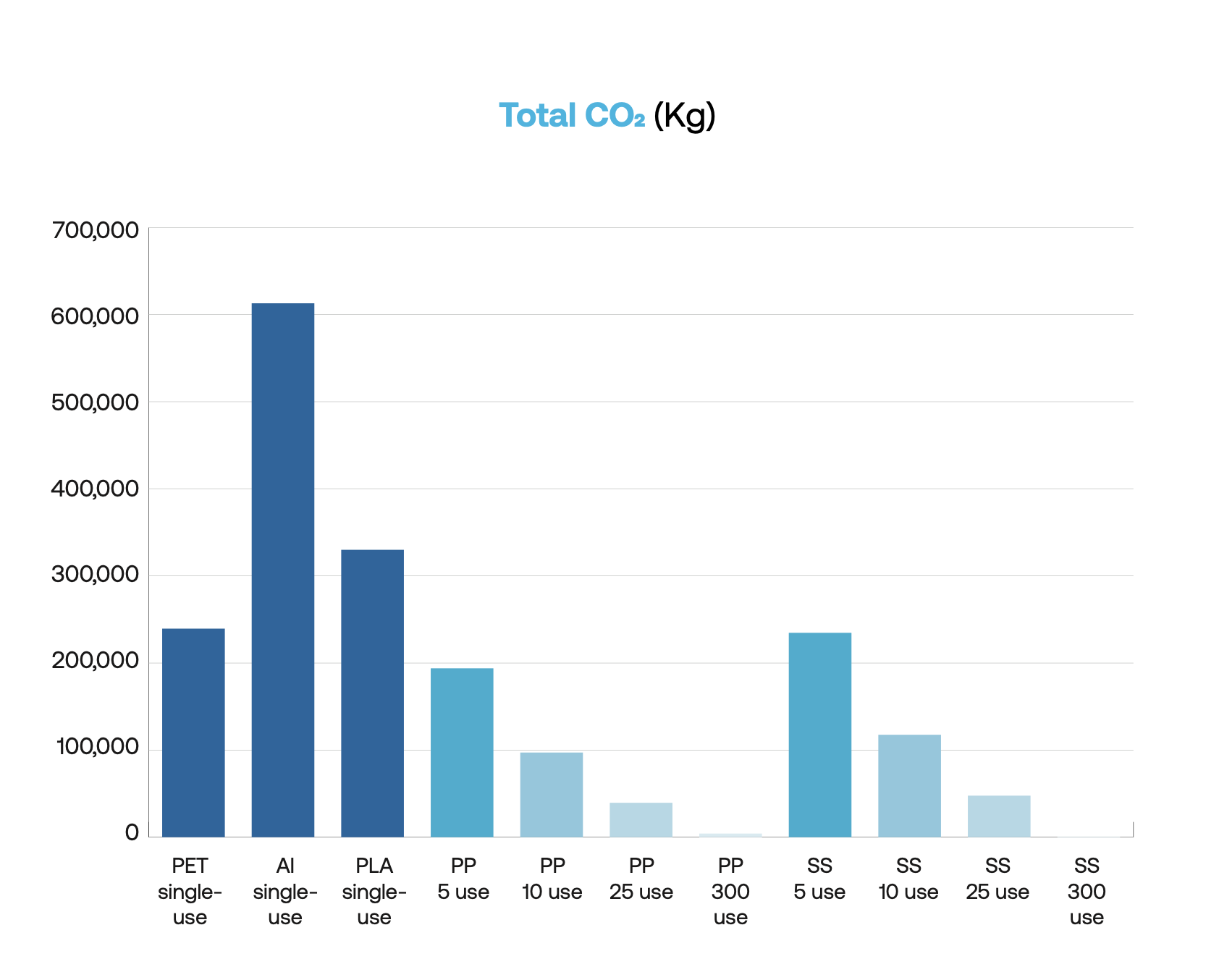Eliminating single-use cups at events
With fans returning to sporting arenas and concert-goers celebrating the return of music festivals, sustainability issues at events and venues are coming back into focus — specifically, the ever-present disposable plastic cup.
Many attempts at solutions have been introduced, from bioplastic to reuse systems and now single-use aluminum cups. But there has been no clear scientific consensus as to which options have the greatest environmental impact and which options have the least — until now.
Running the numbers
At Upstream, we commissioned a life-cycle assessment to examine the environmental impacts from single-use and reusable cups made from different materials. The analysis focused on cups used in arena and stadium events within the United States during an average event season.
In short, we looked at the most commonly-used single-use plastic cup made from PET; a single-use bio-plastic cup made from PLA; a single-use aluminum cup; and two of the most common reusable options - reusable polypropylene and reusable stainless steel - under different use scenarios, like 5, 10, 25 or 300 uses.
Carbon footprint of various single-use and reusable cups over their lifetime
Key Findings
The research showed three key findings:
Reusable stainless steel and polypropylene cups dramatically outperform the single-use cup options across all environmental metrics. These are the most sustainable options for events and venues. And the use category — transportation and washing — for the reusable cups had a minor impact for all use cases in comparison to single-use cups.
To break this down, a reusable polypropylene cup used 300 times (which is the average life of the cup) creates 60 times less carbon pollution than 300 single-use PET plastic cups and 68 times less waste. A reusable stainless steel cup used 300 times creates 166 times less carbon pollution and 36 times less waste than single-use plastic cups.If you’re still using single-use cups, PET and PLA cups are better options for the climate; single-use PET actually beats out bioplastic. Although we don’t recommend the use of single-use cups.
And single-use aluminum cups are the worst option for the climate by far. In the current recycling scenarios for the US, single-use aluminum cups used 47% more energy over their life-cycle and created 86% more carbon dioxide than other single-use plastic options.
What’s up with aluminum cups?!
We know that the findings on aluminum cups have generated some controversy, especially as aluminum cup manufacturers are working with venues to trade out single-use plastic for single-use aluminum. The assumptions we used in the study for the current case scenario were straight from the Aluminum Association: 73% recycled content for the cup and a 46.1% recycling rate.
However, we also looked at a best case scenario, in which the cup is made from 100% recycled aluminum and 100% of the cups are collected for recycling post-event. Even in this completely optimal scenario, single-use aluminum still had twice as many climate emissions as single-use plastic. And reusable polypropylene cups that are used 50 times created 24 times less carbon pollution than the single-use aluminum; reusable stainless steel used 50 times generated 18 times less carbon pollution.
“Reusable polypropylene cups that are used 50 times created 24 times less carbon pollution than the single-use aluminum; reusable stainless steel used 50 times generated 18 times less carbon pollution. ”
Envisioning waste-free venues
The average stadium that hosts 300 events annually uses 5.4 million single-use cups – creating a whopping 64 tons of plastic waste. If these were replaced with reusable polypropylene (PP) cups used 300 times and then discarded, that would generate less than one ton of waste. Reusable stainless steel cups used 300 times and then discarded would generate just about 2 tons of waste. Given that polypropylene and stainless steel can also be recycled – and in the case of steel, recycled endlessly – it’s possible to trade out 64 tons of plastic garbage for a completely zero-waste reuse service for cups.
And that’s our core recommendation:
Venues and events companies should begin the process of shifting away from all single-use cups, not just single-use plastic. Venues and events companies can either a) create their own reusable cup systems, b) license 3rd party systems, or c) hire reuse companies to provide the service for them.
Secondly, from a climate perspective, single-use aluminum cups are not a sustainable option when compared to other single-use cups or reusable cups, even if all of the aluminum cups are collected for recycling.
Third, stainless steel is the preferred choice for all venues and events locations that allow it. It can be used many more times than reusable plastic and is better for the environment and people all around.
There are ways to save and make money from deploying reusable cup systems, including: a) savings on disposables procurement, b) savings on waste management costs, c) savings on clean-up and litter, d) opportunities for brand partnerships and brand loyalty, and e) opportunities for tech integration, special offers and valuable customer use data.
With all the attention on single-use plastic, venue owners and operators and events companies are rightly looking to reduce their plastic footprint. Unfortunately, trading one single-use product for another generally means we're trading one set of environmental problems for others. The good news is that reuse wins for the environment every time. And companies are innovating to get us what we want and need without all the waste.
Interested in learning more?
Access the full life-cycle report of reusable and single-use cups at events.
Watch Indisposable Live: Reuse Wins at Events: a panel discussion with Green Sports Alliance, r.Cup and TURN, held on March 24, 2022.


